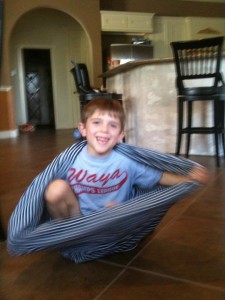No beach? No problem! I shared in an earlier post about creating a Sand Bin and how that can be used to hide items to increase sensory tolerance and build hand muscles through sand play. This bin can also be used to build handwriting skills by having your child do some sand writing.
One of the things I learned last year when Andrew attended a handwriting camp was the importance of providing opportunities for children to build handwriting skills in:
- large ways (ex. writing really big on a white board)
- medium ways (ex. sand or salt writing)
- small ways (ex. pencil/paper).
Side note: At Michael’s this morning, I noticed that in addition to regular decorative sand, they had small containers of sand in a variety of colors (in the discount/$1 racks at the front of the store), probably to make those sand in the bottle crafts, but for a few dollars, this sand could be poured onto a rimmed cookie sheet for an easy to assemble writing station. How fun!!
My Obstacle Course Station Activity: Sand Writing
What to include at this station:
- Play sand in a bin or rimmed tray
- Towel underneath to catch any stray sand
- I provide a spray bottle with water so that Andrew can get the sand wet (sand is great to get wet because it makes it easier to write in and dries for future uses!)
- Pouch with letters for them to choose and write
- Dice to roll and write
- Flash cards or cutouts with shapes or words to practice drawing or writing
- Tools to help:Â wooden spoon to flip around and use the end like a pencil if your child has sensory issues and doesn’t like the feel of sand on their hands; something with a flat edge to smooth the sand before writing the next letter, number, shape or word
At the station, they practice writing shapes, numbers, letters or words in the sand. This seems and is super simple but it has really allowed me to see if he is forming things like his letters and numbers correctly.
Sand writing utilizes all learning styles (visual, auditory, kinesthetic):
- the child is seeing what they are drawing or writing (this is done through the letters they choose)
- hearing what they are drawing or writing (saying it out loud while they are doing it, even adding some dialogue such as, “A square has four sides made of four straight lines. First line – stop. Go down for second line – stop. Go across for the third, bottom line – stop. Go up for the fourth and last line – stop.)
- actually making the shapes, numbers, letters or words.
Here is a variation of sand writing using salt in a foil pan -Â Salt Writing. Note: Do not get the salt wet!
Engage, Encourage and Empower!












